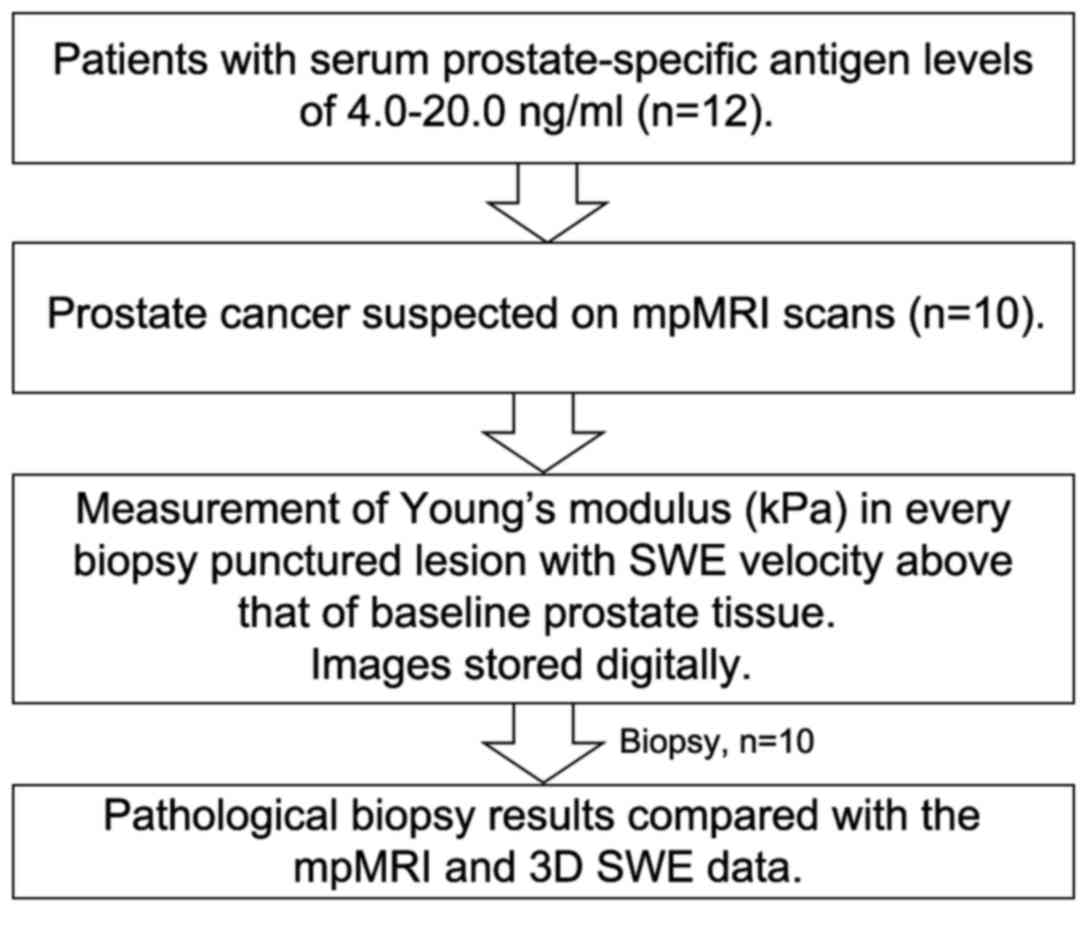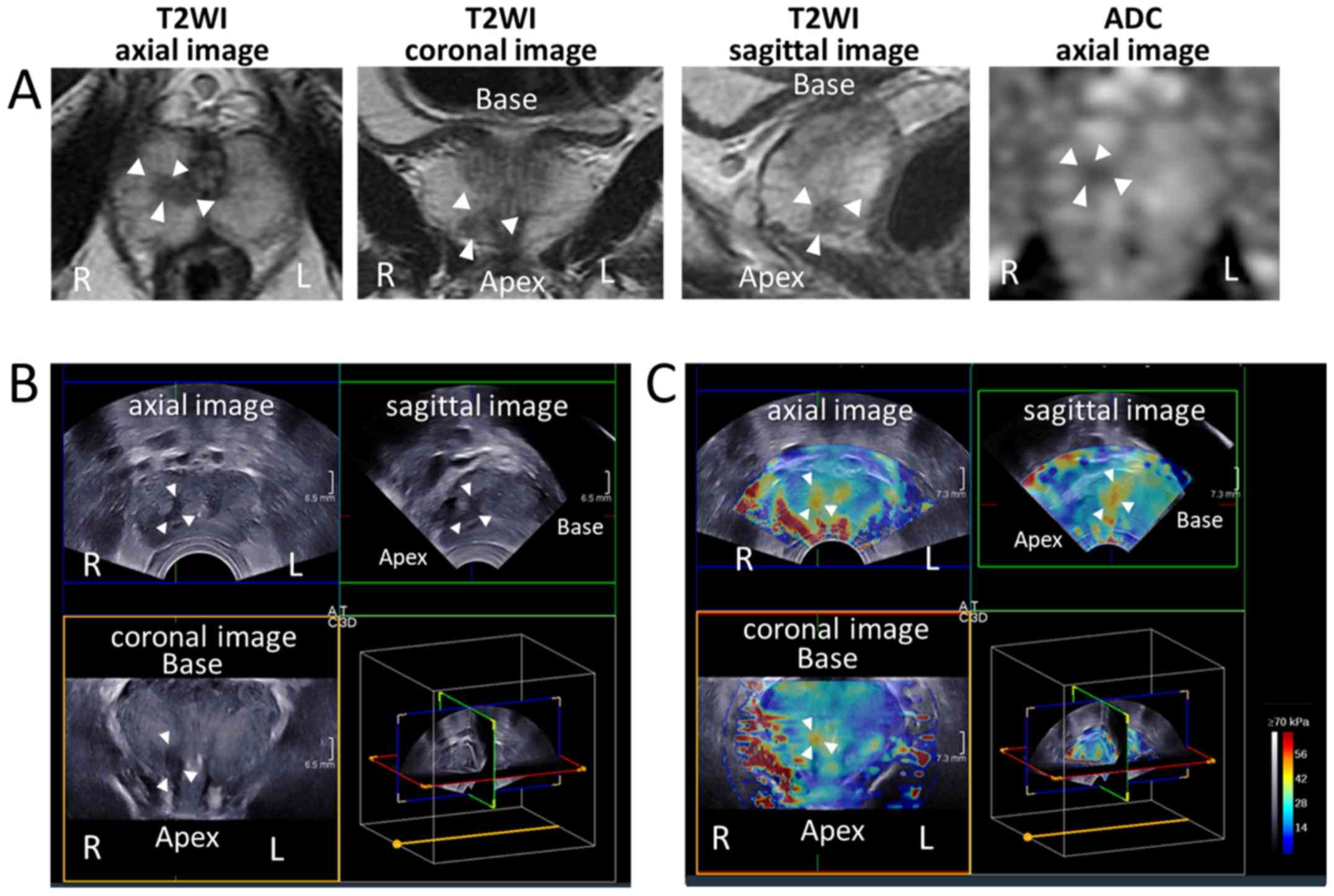|
1
|
Postema A, Mischi M, de la Rosette J and
Wijkstra H: Multiparametric ultrasound in the detection of prostate
cancer: A systematic review. World J Urol. 33:1651–1659. 2015.
View Article : Google Scholar : PubMed/NCBI
|
|
2
|
Good DW, Stewart GD, Hammer S, Scanlan P,
Shu W, Phipps S, Reuben R and McNeill AS: Elasticity as a biomarker
for prostate cancer: A systematic review. BJU Int. 113:523–534.
2014. View Article : Google Scholar : PubMed/NCBI
|
|
3
|
Aigner F, Pallwein L, Schocke M, Lebovici
A, Junker D, Schäfer G, Mikuz G, Pedross F, Horninger W, Jaschke W,
et al: Comparison of real-time sonoelastography with T2-weighted
endorectal magnetic resonance imaging for prostate cancer
detection. J Ultrasound Med. 30:643–649. 2011. View Article : Google Scholar : PubMed/NCBI
|
|
4
|
Correas JM, Tissier AM, Khairoune A,
Khoury G, Eiss D and Hélénon O: Ultrasound elastography of the
prostate: State of the art. Diagn Interv Imaging. 94:551–560. 2013.
View Article : Google Scholar : PubMed/NCBI
|
|
5
|
Nelson ED, Slotoroff CB, Gomella LG and
Halpern EJ: Targeted biopsy of the prostate: The impact of color
Doppler imaging and elastography on prostate cancer detection and
Gleason score. Urology. 70:1136–1140. 2007. View Article : Google Scholar : PubMed/NCBI
|
|
6
|
Ophir J, Garra B, Kallel F, Konofagou E,
Krouskop T, Righetti R and Varghese T: Elastographic imaging.
Ultrasound Med Biol. 26 Suppl 1:S23–S29. 2000. View Article : Google Scholar : PubMed/NCBI
|
|
7
|
Mitri FG, Urban MW, Fatemi M and Greenleaf
JF: Shear wave dispersion ultrasonic vibrometry for measuring
prostate shear stiffness and viscosity: An in vitro pilot study.
IEEE Trans Biomed Eng. 58:235–242. 2011. View Article : Google Scholar : PubMed/NCBI
|
|
8
|
Woo S, Kim SY, Lee MS, Cho JY and Kim SH:
Shear wave elastography assessment in the prostate: An
intraobserver reproducibility study. Clin Imaging. 39:484–487.
2015. View Article : Google Scholar : PubMed/NCBI
|
|
9
|
Barr RG, Memo R and Schaub CR: Shear wave
ultrasound elastography of the prostate: Initial results.
Ultrasound Q. 28:13–20. 2012. View Article : Google Scholar : PubMed/NCBI
|
|
10
|
Harnden P, Naylor B, Shelley MD, Clements
H, Coles B and Mason MD: The clinical management of patients with a
small volume of prostatic cancer on biopsy: What are the risks of
progression? A systematic review and meta-analysis. Cancer.
112:971–981. 2008. View Article : Google Scholar : PubMed/NCBI
|
|
11
|
Vilanova JC, Barceló-Vidal C, Comet J,
Boada M, Barceló J, Ferrer J and Albanell J: Usefulness of
prebiopsy multifunctional and morphologic MRI combined with
free-to-total prostate-specific antigen ratio in the detection of
prostate cancer. AJR Am J Roentgenol. 196:W715–22. 2011. View Article : Google Scholar : PubMed/NCBI
|
|
12
|
Delongchamps NB, Rouanne M, Flam T, Beuvon
F, Liberatore M, Zerbib M and Cornud F: Multiparametric magnetic
resonance imaging for the detection and localization of prostate
cancer: Combination of T2-weighted, dynamic contrast-enhanced and
diffusion-weighted imaging. BJU Int. 107:1411–1418. 2011.
View Article : Google Scholar : PubMed/NCBI
|
|
13
|
Barentsz JO, Richenberg J, Clements R,
Choyke P, Verma S, Villeirs G, Rouviere O, Logager V and Fütterer
JJ; European Society of Urogenital Radiology, : ESUR prostate MR
guidelines 2012. Eur Radiol. 22:746–757. 2012. View Article : Google Scholar : PubMed/NCBI
|
|
14
|
Röthke M, Blondin D, Schlemmer HP and
Franiel T: PI-RADS classification: Structured reporting for MRI of
the prostate. Rofo. 185:253–261. 2013.(In German). PubMed/NCBI
|
|
15
|
Hamoen EHJ, de Rooij M, Witjes JA,
Barentsz JO and Rovers MM: Use of the Prostate Imaging Reporting
and Data System (PI-RADS) for Prostate Cancer Detection with
Multiparametric Magnetic Resonance Imaging: A Diagnostic
Meta-analysis. Eur Urol. 67:1112–1121. 2015. View Article : Google Scholar : PubMed/NCBI
|
|
16
|
Oto A, Kayhan A, Jiang Y, Tretiakova M,
Yang C, Antic T, Dahi F, Shalhav AL, Karczmar G and Stadler WM:
Prostate cancer: Differentiation of central gland cancer from
benign prostatic hyperplasia by using diffusion-weighted and
dynamic contrast-enhanced MR imaging. Radiology. 257:715–723. 2010.
View Article : Google Scholar : PubMed/NCBI
|
|
17
|
Shoji S, Hiraiwa S, Ogawa T, Kawakami M,
Nakano M, Hashida K, Sato Y, Hasebe T, Uchida T and Tajiri T:
Accuracy of real-time magnetic resonance imaging-transrectal
ultrasound fusion image-guided transperineal target biopsy with
needle tracking with a mechanical position-encoded stepper in
detecting significant prostate cancer in biopsy-naïve men. Int J
Urol. 24:288–294. 2017. View Article : Google Scholar : PubMed/NCBI
|
|
18
|
Gleason DF, Mellinger GT, Arduino LJ,
Bailar JC III, Becker LE III, Berman HI III, Bischoff AJ, Byar DP,
Blackard CE, Doe RP, et al: Prediction of prognosis for prostatic
adenocarcinoma by combined histological grading and clinical
staging. J Urol. 111:58–64. 1974. View Article : Google Scholar : PubMed/NCBI
|
|
19
|
Ahmad S, Cao R, Varghese T, Bidaut L and
Nabi G: Transrectal quantitative shear wave elastography in the
detection and characterisation of prostate cancer. Surg Endosc.
27:3280–3287. 2013. View Article : Google Scholar : PubMed/NCBI
|
|
20
|
Correas JM, Tissier AM, Khairoune A,
Vassiliu V, Méjean A, Hélénon O, Memo R and Barr RG: Prostate
cancer: Diagnostic performance of real-time shear-wave
elastography. Radiology. 275:280–289. 2015. View Article : Google Scholar : PubMed/NCBI
|
|
21
|
Woo S, Kim SY, Cho JY and Kim SH: Shear
wave elastography for detection of prostate cancer: A preliminary
study. Korean J Radiol. 15:346–355. 2014. View Article : Google Scholar : PubMed/NCBI
|












